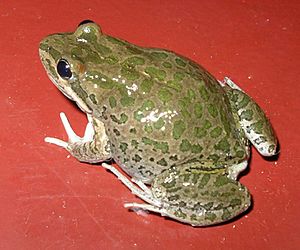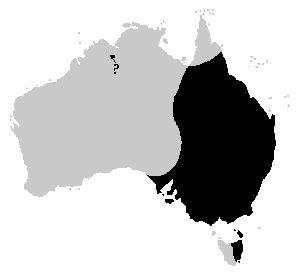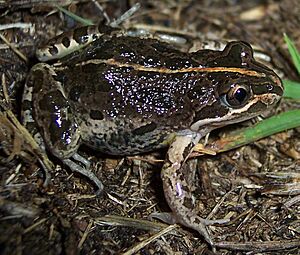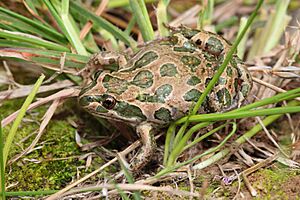Spotted grass frog facts for kids
Quick facts for kids Spotted grass frog |
|
|---|---|
 |
|
| Conservation status | |
| Scientific classification | |
 |
|
| Spotted grass frog range |
The spotted grass frog (also known as the spotted marsh frog) is a type of frog that lives on land in Australia. Its scientific name is Limnodynastes tasmaniensis. You can find these frogs in many parts of Australia, including New South Wales, Victoria, eastern South Australia, most of Queensland, and eastern Tasmania. They also ended up in Western Australia by accident in the 1970s, when some houses were moved to Kununurra from Adelaide.
Long ago, in South Australia, this frog was sometimes called the "Marbled frog." But that name can be confusing because another frog, Limnodynastes convexiusculus, which lives in northern Australia and southern New Guinea, also uses that name.
Contents
What Does It Look Like?
This frog can grow up to 45 mm (about 1.7 inches) long. Its skin can be light brown or olive-green. It has large, unevenly shaped green or brown spots on its back.
Sometimes, a thin, pale cream, yellow, or bright orange stripe runs from its nose all the way to its rear end. There is also a raised pale stripe that goes from below its eye to the base of its arm. The frog's arms and legs have spots just like its back, and its belly is white.
Where Do They Live and What Do They Do?
This frog is very common across Australia. It is often one of the first animals to move into new dams and ditches. You can find these frogs in many different places, such as:
- Permanent or temporary dams
- Roadside ditches
- Ponds
- Flooded grasslands
- Slow-moving creeks
They live in cities, on farms, in woodlands, near the coast, and even in dry areas. You will usually find the spotted grass frog hiding in grass or under other cover, always close to a still water source.
Life Cycle and Reproduction
Male spotted grass frogs call out, and breeding happens almost all year round, except during summer. The sound of their call changes depending on where they live:
- In NSW and QLD, their call sounds like a fast "machine gun" burst.
- In southern VIC and TAS, their call is a single "Tok" sound.
You can tell male and female frogs apart by looking at their thumbs. Females have a flap of skin around their thumbs. They use this skin to make the water foamy during amplexus (when frogs mate). This foam creates a floating nest, about the size of a human palm, where the female lays her eggs.
The tadpoles of this frog are quite large, growing up to 6 cm (about 2.3 inches). These tadpoles stay in the tadpole stage for at least three months before turning into frogs.
Similar Frogs
People often confuse the spotted grass frog with the Long-thumbed frog (Limnodynastes fletcheri). These two frogs live in some of the same areas.
You can tell them apart because the long-thumbed frog has a much longer second toe on its inner front foot. The long-thumbed frog also has bigger, uneven spots on its back and often has red or purple eyelids, which is rare for the spotted grass frog.
Spotted Grass Frogs as Pets
In Australia, you can keep a spotted grass frog as a pet, but you need to have the right permit to do so.
See also
 In Spanish: Limnodynastes tasmaniensis para niños
In Spanish: Limnodynastes tasmaniensis para niños




